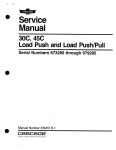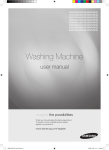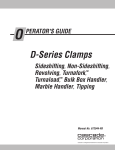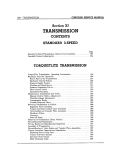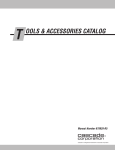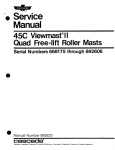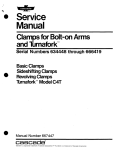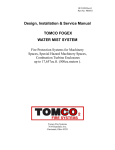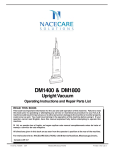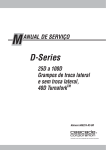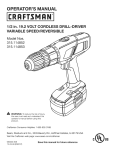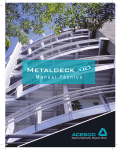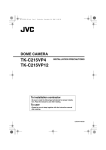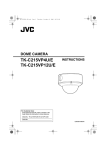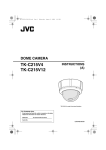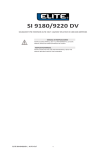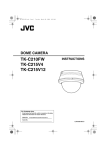Download Clamps - Cascade Corporation
Transcript
Manual D-Series Non-Sideshifting and Sideshifting Clamps 40D Turnafork Serial Numbers 668686 through Fork Clamps Bale Clamps Drum Clamps Multi-Purpose/Rigid Arm Clamps Clamps without Arms Turnafork Clamps Manual Number 669224 R-3 cascade Cascade is a RegIstered Trademark al Cascade Corporation l Turnafork is a Trademark of Cascade Corporatton 681754 Contents INTRODUCTION, Section 1 ....................... INSTALLATION INSTRUCTIONS, Section 2 ...... ............................ Truck Requirements lnstallation ...................................... Customer Fabricated Arm lnstallation ........... Prior to Operation ............................... PERIODIC MAINTENANCE, Section 3 ............ TROUBLESHOOTlNG, Section 4 ................. General Procedures ............................. Plumbing - 25D, 35D, 40D, 50D Clamps ........ Plumbing - 70D, 80D Clamps ................... ......................... Clamp Troubleshooting SERVICE, Section 5 ............................... ................ Clamp Removal and lnstallation Arms ............................................ Arm Assembly Removal and lnstallation ...... ........ Bolt-On Arm Removal and lnstallation Multi-Purpose/Rigid.and Drum Arm Contact Surface Replacement .............. Rigid Arm Contact Pad Rotation and Replacement .................................. Arm Bearing Removal and lnstallation ........ Turnafork Arm Service ........................ Turnafork Arm Indexing ....................... Cylinders ........................................ ............ Cylinder Removal and lnstallation Cylinder Service ................................. Cylinder Disassembly ......................... Cylinder Inspection ........................... Cylinder Reassembly ......................... Restrictor Cartridges ............................ .............. Restrictor Cartridge Adjustment Restrictor Cartridge Service ................... Check Valves ................................... Check Valve Removal and lnstallation ........ Check Valve Service - 25D, 35D, 40D, 50D Clamps ........................... Check Valve Service - 70D, 80D Clamps ..... Eliminating the Arm Opening Regenerative Function ...................... Base Unit ....................................... Frame and Mounting Plate Disassembly and Reassembly ............................ SPECIFICATIONS, Section 6 ...................... Hydraulics ....................................... Truck Carriage .................................. Torque Values ................................... Page Number 1 1 1 2 5 6 7 8 8 10 13 16 19 19 20 20 21 21 22 22 23 24 25 25 27 27 27 28 29 29 29 30 30 31 32 32 33 33 34 34 34 35 669224 Rev. 3 . 1 Introduction Section This manual provides the installation instructions, periodic maintenance requirements, troubleshooting procedures and service guides for D-Series Non-Sideshifting and Sideshifting Clamps and 40DTurnafork. Note that all specifications are shown in US and (Metric) units where applicable. 1.1 Special Instruction Definitions A statement preceded by A WARNING is information that should be acted upon to prevent bodily injury. A WARNING is always inside a ruled box. CAUTION A statement preceded by CAUTION is information that should be acted upon to prevent Machine Damage. IMPORTANT A statement preceded by IMPORTANT is information that possesses special significance. NOTE A statement preceded by NOTE is information that is handy to know and may make your job easier. l Section 2 lnstallation Instruct ions HydraulicSpecifications truck/attachment combination is a responsibility of the original truck manufacturer and may be less than that shown on the attachment nameplate. Consult the truck Pressure-Maximum Recommended Flow-Minimum@ 2.1 Truck Requirements l Truck Relief Valve Setting: 2300 psi (160 bar), maximum. 2000 psi (140 bar), recommended Hydraulic flow should fall within the volume range shown in the table. The truck hydraulic system must supply oil to the attachment that meets the specifications shown in the table. l Recommended hose and fitting size: No. 6 with minimum fitting orifices of 9/32 in. (7mm). No. 8 with minimum fitting orifices of 13/32 in. (1Omm). 0 Truck carriage must conform to IS0 dimensional standard 2328, equivalent to Industrial Truck Association (ITA) dimensions shown in Section 6.1-2. 669224 l Make sure the truck carriage is clean and the notches are undamaged. l In order to conform to industry standard practice, the hoses should be connected to the truck auxiliary valve as indicated by the chart in Section 6.1-l. Rev. 3 Recommended Maximum 250 350,40D 500,70D, 2300 psi 2300 psi 2300 psi (160bar) (160bar) (160bar) 2000 psi 2000 psi (140bar) (140bar) 2000 psi (140bar) 4 GPM 4 GPM (15Umin) (15Umin) 4 GPM (Wmin) 5.5 GPM 7 GPM (21Umin) (26Umin) (38Umin) 5.5 GPM 7GPM (21Umin) (26Umin) ,, 10GPM (38Umin) I Supply Hose and Fitting Size Minimum Orifice Size 8OD 10GPM 1 No.6 (Sideshift) 9/32in.(7mm) No.8 (Clamp) 13/32in.(10mm) 0 Flow less than minimum will result in unequal arm movement. 0 Flow greater than maximum can result in excessive heating, reduced system performance and short hydraulic system life. Hydraulic Oil -Cascade attachments are compatible with SAE 1OWpetroleum base oil per Mil. Spec. MIL-0-5606or MIL-O-2104B. Use of synthetic or aqueous base hydraulic oil is not recommended. Contact Cascade if fire resistant hydraulic oil must be used. 1 Section 2 Installation Instructions 2.2 lnstallation 1 install two 1/2-I3 NC (M 12) eyebolts and a suitable overhead chain hoist to the frame. Set the clamp vertical A 2 WARNING: Make sure your overhead hoist has a rated capacity of at least 2000 Ibs. (900 kg). Connect the hydraulic hoses to the attachment using Cascade Attachment lnstallation Kit No. 659245 for non-sideshifting clamps and clamps with solenoid adaption, Kit No. 659249 for sideshifting clamps OR use hoses and fittings as shown. Position the truck carriage behind the attachment to determine hose lengths required to connect hoses to the hose terminal kits. Remove the hose and cut to length as required. A Hoses should not project above the Check Valve Bracket. WARNING: Do not remove the fitting from the valve clamp (CL) port. For No. 6 hose connection, use a 6-8 reducer. No. 8 Hoses (SAE 100 I?5 Type Single Wire Braid Rubber Covered) Sideshift right/left (These hoses apply to sideshifting clamps only). \ / No. 8 Hoses (SAE 100 R5 Type Single Wire Braid Rubber Covered) Close/Open 0 70D, 80D Clamps Sideshift Left - De-energized Open - Energized Sidshift Right - De-energized Close - Energized 25D, 35D, 40D, 50D Clamps Sideshift Left - De-energized Sideshift Right - De-energized Sideshift Right - De-energized Close - Energized \ Sideshift Left - De-energized Open - Energized 250, 35D,,40D, 50D Clamps Solenoid Adaption with Backrest 2 25D. 35D. 40D. 50D Clamps Solenoid Adaption without Backrest 669224 Rev. 3 . Section 2 lnstallation lnstructions 2.2 lnstallation (Continued) CAUTION: Flush the hoses as follows to prevent damage to the attachment hydraulic components. 3 Connect hoses to the truck hose terminal kits. Connect the hoses together using union fittings. Start the truck and actuate the truck control valves in both directions for about 30 seconds to carry any debris left in the hoses to the truck hydraulic tank and filter. 4 Remove the union fittings and disconnect hoses from the hose terminal kits. Connect hoses to the attachment fittings as shown in step 2. 5 Install the Quick Change lower mounting hooks. For Bolt-On type hooks, proceed to step 6. Quick Change Type A- Install the components as shown. Tighten the capscrews to a torque of 105-115 ft.-lbs. (140-155 N.m). Quick Change Type Ba. install the guides to the baseplate mounting holes with the guide hole offset in the upward position- 5/8 in. (16mm) from top of guide to hole center. Tighten the capscrews to a torque of 105-115 ft.-lbs. b.Slide the hooks over the top of the guides, Install each locking pin through the hook lower hole. 6 Center the lift truck behind the attachment. Tilt the mast forward. Engage the mounting hook tab with the closest upper carriage bar notch and raise the truck carriage into position behind the attachment, Lift the attachment 2 in. (5cm) off the pallet. NOTE: The attachment may not be perfectly centered on the carriage bar when the mounting hook tab is engaged in the carriage notch. WARNING: The mounting hooks must be properly engaged with the upper carriage bar. The tab on the left mounting hook must be engaged in the mating notch on the upper carriage bar. NOTE: The lower hooks cannot be properly installed if the upper hook tab is not engaged in the carriage notch. 669224 Rev. 3 2 lnstallation lnstructions Section 2.2 lnstallation (Continued) 7 lower carnage bar Engage the lower hooks with the truck lower carriage bar. Bolt On type-Install the hooks and capscrews. Tighten the capscrews finger tight. Tap the end of the hooks with a hammer in the direction of the adjust arrow for maximum engagement with the carriage bar. Tighten the capscrews to a torque of 105-115 ft.-lbs. (140-155 N,m). Quick Change Type A-Turn both hooks up and reinstall the pin. The maximum allowable clearance between the hooks and carriage bar is 118in. (4mm) as shown. Bolt On Hooks Quick Change Hooks Truck lower Quick ChangeType B-Remove the locking pins. Slide the hooks up to engage with the carriage bar. Install the locking pins through the upper holes, CAUTION: If the clearance between the carriage bar and the hooks exceeds 3/16 in. (6mm), the guides (refer to step 5) should be inverted and installed with the hole offset downward - 5/8 in. (16mm) from bottom of guide to hole center to minimize the gap. lower hook Clamp hoses Hydraulic 8 Quick I Optional Hydraulic Quick Disconnect Coupling Kits No, 671045 can be installed at this time. One kit is required for non-sideshifting clamps, two kits are required for sideshifting clamps. These kits allow fast removal of the attachment from the truck without the use of tools. Included with the kit is lnstallation Instruction No. 671422. Each pair of hoses requires a coupling kit. 9 Connect the attachment hoses to the hose terminal fittings. See the chart in Section 6.1-i for correct auxiliary valve and attachment function operation. 669224 Rev. 3 Section 2.2 2 Installation lnstructions lnstallation (Continued) Drive 10 Tighten the arm capscrews as described in step 1 of Customer Fabricated Arm installation, Section 2.3. 2.3 Extention Customer Fabricated Arm lnstallation (Clamps without Arms) Clamps without arms are supplied with two arm bases. Special forks can be welded directly to them or they can be used as a base to fabricate custom built arms. WARNING: Use a certified welder and proper welding procedures when welding arms to the arm bases. CAUTION: Weld fabricated arms to the arm bases only. Do not weld or bolt special built arms or forks directly to the arm bars. Arm. Base The arm base material is AISI C-1020 with the following specifications: TENSILE STRENGTH-61,000 PSI min. (420mPa) YIELD STRENGTH-43,000 PSI min. (3OOmPa) CARBON CONTENT-23% max. CAUTION: The surface flatness of the arm base must remain within ,010 in. (.25mm) in bolt area and arm bars must slide free manually. 1 Fasten the arm bases to the arm bars. Tighten the capscrews to the torque values indicated in the chart with drive extension tool 668020 for 25D attachments, 667699 for 35D, 40D, 50D attachments or 676218 for 70D attachments. A torque multiplier is required to tighten the 70D capscrews. The torque multiplier and drive extension tools can be ordered by contacting: Model Tool Part No. 25D 668020 35D 1 667699 669224 Rev. 3 190-220ft.-lbs. ft.-lbs. (257-298 N.m) (380-434 N,m) 667699 280-320ft.-lbs. (380-434 N,m) 50D 667699 280-320ft.-lbs. (380-434 N,m) 70D 676218 680-720ft.-lbs. (922-976 N,m) DimensionsModel 25D Short drive adapters are commercially available ref. Williams %” drive to %” hex (25D) and %” drive to 5/B”hex (35D, 40D, 50D) and 3/4”drive to 3/4”hex (70D). Drive extension tool dimensions are provided for you to make your own tool from an allen wrench. Do not use mild steel hex stock. 1 1 280-320 40D Parts Depot Cascade Corporation 2501 Sheridan Ave. Springfield, Ohio 45505 Telephone: (513) 322-1199 Telex: 279563 FAX: (513) 325-9270 IMPORTANT: Be careful not to damage the arm bar. Premature bearing failure will occur. Torque Values for Arm Capscrews A .50(12,7) B .75(19.0) in (mm) C .461(11.6) D 350(88.0) 5 Section 2.3 2 lnstallation lnstructions Customer Fabricated Arm lnstallation (Continued) 2 Lubricate the cylinder rod threads. nut threads and spherical portion of nut with STP. 3 Install the washer on the rod end with the beveled side facing the lug. 4 Engage the rod end into the lug. 5 Tighten the rod end nut to the torque values below, Prevent rod turning by using wrench on hex washer. 25D, 35D, 40D, 50D - 150-l 75 ft.-lbs. (203-237 70D- 222-250 ft.-lbs. (305-340 N.m) N,m) NOTE: The rod end nut is being tightened against the hex washer. The nut will not be tight against the arm base lug. This looseness allows for cylinder alignment during clamping. 6 Install the locking cap and cotter pin. 7 Lubricate the bearing portion of the arm bars with a thin film of chassis grease. Hex washers beveled side facing lug Prior to Operation 1 Check the cylinder anchor nuts for properly installed locking caps and cotter pins. 2 Check for external leaks at the fittings and rod ends. NOTE: The 25D, 35D, 40D and 50D clamps utilize a regenerative hydraulic circuit in the arm opening mode. The arms will open at a faster speed than when closing. This is a normal clamp function. If required the regenerative function can be eliminated. Refer to Section 5.6-2. 3 Check for properly installed locking caps and cotter pins Check for equal arm travel. If the travel is unequal, the restrictor cartridges can be adjusted as follows: a. Loosen the jam nuts on the restrictor cartridges. Screw in the plungers until they bottom. Screw each plunger out three full turns. Restrictor Cartridge b. Activate the arms to the fully open position, c. Activate the arms to close until one arm bottoms out. Measure the amount of stroke remaining in the opposite arm. d. If the unequal closing movement exceeds 2 in., screw the plunger in l/2 turn on the cylinder that bottomed first. e. Repeat steps b through cl until unequal closing movement is less than 2 in. 4 Before picking up a load, operate the clamp through several full cycles to force any air from the system to the hydraulic tank. WARNING: Make sure there are no people in the vicinity of the attachment when picking up a load. 6 669224 Rev. 3 Section 3 Periodic Maintenance 3.1 100 Hour Maintenance Every time the lift truck is serviced or every 100 hours of truck operation, whichever comes first, complete the following maintenance procedures: After completing any service procedure, always test each function through 5 complete cycles. First test the clamp test each function with a load to make sure the attachment operates correctly before returning it to the job. Inspect the cylinder anchor nuts for correct hold. q Apply wheel bearing grease to the spherical portion of the cylinder anchor nuts. Arm bearing life can be extended with periodic light lubrication. If your application warrants, apply a thin film of chassis grease to the bearing portion of the arm bars. IMPORTANT: Tighten the arm capscrews. A torque multiplier is required to tighten the 70D, 80D capscrews. Refer to Section 2.3. 3.2 500 Hour Maintenance After each 500 hours of lift truck operation, in addition to the IOO-hour maintenance procedures, perform the following: Tighten the lower hook capscrews. Use the torque specifications shown in Section 6.l-3. Cl 70D, 80D Clamps-Tighten the upper hook capscrews. Use the torque specification shown in Section 6.1-3. 3.3 1000 Hour Maintenance After each 1000 hours of lift truck operation, in addition to the lOO-hour and 500-hour maintenance procedures, perform the following. Inspect the arm bearings. If the bearings are worn in any area to a thickness less than ,040 in. (1 mm), they must be replaced. See Section 5.2-5. 3.4 2000 Hour Maintenance After each 2000 hours of lift truck operation, in addition to the IOO-hour, 500-hour, and IOOO-hour maintenance procedures, perform the following procedures. Cl Replace all arm bearings. See Section 5.2-5. Tighten the frame/mounting plate capscrews. Use the torque specification shown in Section 6.1-3. 669224 Rev. 3 7 Section 4 Troubleshooting General Procedures A After completing any service procedure, always test the function through several cycles. First test the attachment empty to bleed airtrapped in the system to the truck system. Then test the attachment with a load to be sure it operates correctly before returning it to the job. I Stay clear of the load while testing. Do not raise the load more than 3 in. (7cm) off floor while testing. 4.1-1 Truck System Requirements 4.1-2 Hydraulic Specifications WARNING: Before servicing any hydraulic component, relieve pressure in the system. Turn the truck off, and open the truck auxiliary valves several times in both directions. l The lift truck must supply sufficient hydraulic pressure to handle the heaviest load. PRESSURE MUST NOT EXCEED 2300 PSI (160 BAR). l Hydraulic flow should fall within the volume range shown in the table. l The truck hydraulic system must supply hydraulic oil to the attachment that meets the specification shown in the table. 35D, 40D 25D Pressure-Maximum Recommended 500,70D, 80D 2300 psi 2300psi (160bar) (160bar) 2300 psi (160bar) 2000 psi 2000psi (140bar) (140bar) 2000 psi (140bar) 4 GPM 4GPM (15L/min) (15L/min) 4 GPM (l5L/min) Recommended 5.5 GPM 7 GPM (21L/min) (26L/min) 10GPM (38L/min) Maximum 5.5 GPM 7 GPM (21L/min) (26L/min) 10GPM (38L/min) Flow-Minimum@ Supply Hose and Fitting Size Minimum Orifice Size No.6 (Sideshift) 9/32in.(7mm) No.8 (Clamp) 13/32in.(1Omm) 0 Flow less than minimum wtll result in unequal arm movement. 0 Flow greater than maximum can result in excessive heating, reduced system performance and short hydraulic system life. Hydraulic Oil-Cascade attachments are compatible 1OWpetroleum base oil per Mil. Spec. MIL-0-5606or MIL-O-2104B. with SAE Use of synthetic or aqueous base hydraulic oil is not recommended. Contact Cascade if fire resistant hydraulic oil must be used. Tools Required FLOW METER In addition to a normal selection of hand tools, you will need: l A flow meter capable of measuring hydraulic flow to 20 GPM (75 L/min.). The parts shown are included in Cascade Flow Meter Kit Part No. 671477. l A pressure gauge capable of measuring pressure to 2500 psi (175 bar). The parts shown are included in Cascade Pressure Gauge Kit Part No. 671212. l Assorted fittings and a No. 6 hose, as shown, to adapt the gauge and flow meter to the components being tested. (2) No. 6-8 JIC Reducer PRESSURE GAUGE Pressure No. 4-6 Pipe/JIC No. 6 and No. 8 No. 6-8 JIC Reducer *No. 6-8 JIC/O-ring I I *Not included in Pressure Gauge Kit part no. 671212 669224 Rev. 3 Section 4 Troubleshooting 4.1-3 Get All The Facts Before You Begin Working On The Clamp It IS Important that you gather all the facts regarding the problem before you begin service procedures. The best way IS to talk with the operator. Ask for a complete description of the malfunction. The following guidelines will help you decide where to begin your troubleshooting procedures. NOTE: The 25D, 35D, 40D and 50D clamps utilize a regenerative hydraulic circuit in the arm opening mode. The arms will open at a faster speed than when closing. This is a normal clamp function. l Clamp drops load after it has been picked up. Clamp Will not carry load up to its rated capacity. l Clamp arms have uneven travel Clamp arms travel slowly. Clamp arms Will not move. If you encounter 4.4-l. one of these problems, refer to Paragraph Clamp drops the load when sideshifting. If you encounter 669224 Rev. 3 this problem, refer to Paragraph 4.4. 9 Section 4 Troubleshooting 4.2 Plumbing - 25D, 35D, 40D, 5OD Clamps 4.2-l Hosing Diagram, Non-Sideshifting Clamps Cylinder ARMS OPENING PRESSURE REGENERATING 4.2-2 Circuit Schematic, ARMS CLOSING Hose Terminal Non-Sideshifting Clamps Valve 10 Truck Hydraulic Pump 669224 Rev. 3 Section 4.2-3 4 Troubleshooting Hosing Diagram, Sideshifting Clamps (including Turnafork) PRESSURE REGENERATING Hose Terminal Clamps with Solenoid Adaption Hose Reel ARMS CLOSING PRESSURE RETURN Clamps with Solenoid Adaption Auxiliary Valve Hose Terminal Hose Reel 669224 Rev. 3 11 Section 4.2-3 4 Troubleshooting Hosing Diagram, Sideshifting Clamps (Cont.) Cylinder SlDESHlFTlNG (SIDESHIFT LEFT SHOWN) PRESSURE RETURN SLAVE Hose Terminal solenoid Hose Terminal Hose Terminal 4.2-4 Hose Reel Auxiliary valve Circuit Schematic, Sideshifting Clamps (including Turnafork) Cylinders Clamps with Solenoid Adaption Hose Terminal V w Hose reel Clamp Auxiliary Valve Sideshift Auxiliary Valve A Truck Relief Valve Truck 12 Relief Valve I Truck Hydraulic 669224 Pump Rev. 3 Section 4 Troubleshooting 4.3 Plumbing - 70D, 80D Clamps Hosing Diagram, Non-Sideshifting 4.3.1 Clamps Check Valve ARMS OPENING ARMS CLOSING Hose Terminal PRESSURE RETURN 4.3-2 Circuit Schematic, Non-Sideshifting Clamps A Cylinders I Check Valve ’ L Clamp - Valve 669224 Rev. 3 Truck Hydraulic Pump 13 Section 4 Troubleshooting 4.3-3 Hosing Diagram, Sideshifting Clamps ARMS OPENING To cylinders Hose Terminal Clamps with Solenoid Adaption valve Hose Terminal Hose Reel e I ARMS CLOSING PRESSURE RETURN To Cylinders Hose Terminal 14 669224 Rev. 3 Section 4.3-3 4 Troubleshooting Hosing Diagram, Sideshifting Clamps (Cont.) SlDESHlFTlNG (SIDESHIFT LEFT SHOWN) PRESSURE RETURN To Cylinders Hose Terminal Hose Terminal 4.3-4 Circuit Schematic, Sideshifting Clamps Cylinders Clamps with Solenoid Adaption IA,..-.3 M-l -h V PI G V r -‘-! Hose Hose reel Clamp Auxiliary Valve Sideshift Auxiliary Valve Truck Relief Valve Truck Hydraulic Pump Truck Relief Valve Truck Hydraulic Pump 15 669224 Rev. 3 Section 4 Troubleshooting 4.4 Clamp Troubleshooting There are four potential problem areas that could affect clamping force. 0 Insufficient hydraulic pressure from the lift truck. 0 External leaks 0 Malfunctioning check valve. Worn or defective cylinder seals. To isolate the problem area, complete the following check list in the exact sequence indicated. 4.4-l 1 WARNING: Before removing any hoses or fittings relieve pressure in the hydraulic system. Turn the truck off. then open the truck auxiliary control valves several times in both directions. Clamp Circuit Pressure Test 1. Check the pressure delivered by the truck. Refer to the truck service manual. The pressure must be within 100 psi (7 bar) of specified truck pressure. TRUCK PRESSURE MUST NOT EXCEED 2300 PSI (160 Bar), measured at the junction block. 2. Check the flow volume at the hose terminal. See Paragraph 6.1-l for the recommended flow volumes. If the truck pressure and flow volume are correct, proceed with the pressure test. 3. Clamps with Solenoid Adaption - Press the auxiliary valve control knob button. Listen for a “click’ at the solenoid valve. If the solenoid valve does not “click” when the button is pushed, check the electrical wiring and solenoid coil. 4 Check for external leaks. Start the truck. Close the arms fully. Hold the clamp control handle In the clamp positron for a few seconds. 5. Return the handle to neutral. Inspect all fittings, lines, and the cylinders for leaks. If there are no leaks, proceed with the pressure test. 90’ fitting and hose 6. 25D, 35D, 40D, 50D Clamps - Install the pressure gauge and hose assembly in the valve test port marked “G”. located on the back of the valve body. 70D, 80D Clamps- Remove the bumper. Install a tee fitting. hose and gauge between the cylinder rod end supply hose and tee fitting as shown. 7 Start the truck. Close the arms fully. Hold the clamp control handle in the clamp position for a few seconds. 8. Return the handle to neutral. Watch the gauge pressure reading. l If the pressure does not drop more than 150 PSI (10 bar) initially, and additional drop does not exceed 25 PSI (2 bar) per minute. the problem is not hydraulic. Refer to Paragraph 4.1-3. l If the pressure drops more than 150 psi (10 bar) initially. and additional drop exceeds 25 psi (2 bar) per minute, proceed with the troubleshooting check list to isolate the faulty component. IMPORTANT: Before removing pressure gauge. momentarily actuate clamp open circuit. This will relieve pressure trapped by the check valve in the clamp circuit Install tee fitting, and gauge. 16 hose 669224 Rev. 3 Section 4 Troubleshooting 4.4-2 Check Valve Pressure Test WARNING: Before removing any hoses, relieve pressure in the hydraulic system. Turn the truck off, then open the truck auxiliary control valves several times in both directions. 1. 25D, 35D, 40D, 50D Clamps2. Remove the bumper. Disconnect the hydraulic lines at the rod end of both cylinders. Cap the ports and plug the lines. 3. Start the truck. Hold the clamp control handle in the clamp position for a few seconds. 4. 25D ,35D, 40D, 50D Clamps Return the handle to neutral. Watch the gauge pressure reading. Disconnect the hydraulic lines at the rod end of both cylinders. Cap the ports and plug the lines. 0 If the pressure drops more than 150 psi (10 bar) initially, and additional drop exceeds 25 psi (2 bar) per minute, the check valve is faulty and requires service. Refer to paragraph 5.5-3 0 If the pressure does not drop more than 150 psi (10 bar) initially, and additional drop does not exceed 25 psi (2 bar) per minute, one or both cylinders require service. Proceed with the troubleshooting check list to isolate the faulty component. IMPORTANT: Before removing pressure gauge, momentarily actuate clamp open circuit. This will relieve pressure trapped by check valves in clamp circuit. 4.4-3 Cylinder Test hoses, relieve pressure in the hydraulic system. Turn the truck off, then open the truck auxiliary control valves several 25D, 35D, 40D, 50D Clamps 1, Connect one of the hydraulic lines to its cylinder. The other line must remain plugged. 2. Start the truck. Hold the clamp control handle in the clamp position for a few seconds. 3. Return the handle to neutral. Watch the gauge pressure reading. l If the pressure drops more than 150 psi (10 bar) initially, and additional drop exceeds 25 psi (2 bar) per minute, the cylinder connected to the check valve is faulty and requires service. Refer to paragraph 5.3-l Connect one of the hydraulic lines to its cylinder. The other line must remain plugged. 0 If the pressure does not drop more than 150 psi (10 bar) initially, and additional drop does not exceed 25 psi (2 bar) per minute, the second cylinder is faulty. Refer to paragraph 5.3-l. It is recommended to perform a similar pressure test for the second cylinder before servicing. IMPORTANT: Before removing pressure gauge, momentarily actuate clamp open circuit. This will relieve pressure trapped by check valves in clamp circuit. 669224 Rev. 3 17 Section 4.4-4 4 Troubleshooting Sideshift Circuit Pressure Test Install fitting, hose and gauge. If the clamp does not sideshift right and left at equal speeds or drops a load while sideshifting, one of the sideshift check valves cartridges is faulty. The two outer cartridges on the front of the valve are for the sideshift circuits. IMPORTANT: Clamps equipped with solenoid adaption must be plumbed to the check valve so the solenoid will be energized for the clamp/open functions. WARNING: Before installing the pressure gauge, relieve pressure in the hydraulic system. Turn the truck off, then open the truck auxiliary control valves several times in both directions. 1. 25D, 35D, 40D, 50D Clamps- Install the pressure gauge and hose assembly in the valve test port marked “G”, located on the back of the valve body. 70D, 80D Clamps- Remove the bumper. Install a tee fitting, hose and gauge between the cylinder rod end supply hose and tee fitting as shown. Sideshift Left Cartridge 2. Stan the truck. Clamp onto a load (lift no more than 1” off ground or floor). Hold the sideshift control handle in the sideshift left position for a few seconds. 3. Return the handle to neutral. Watch the gauge pressure reading. l If the pressure drops more than 150 psi (10 bar) initially, and additional drop exceeds 25 psi (2 bar) per minute, the sideshift left cartridge is faulty and requires service. Refer to paragraph 5.53. l If the pressure does not drop more than 150 PSI (10 bar) initially, and additional drop does not exceed 25 psi (2 bar) per minute, move the sideshift control handle in the sideshift right position for a few seconds. 4. Return the handle to neutral. Watch the gauge pressure reading. l If the pressure drops more than 150 psi (10 bar) initially, and additional drop exceeds 25 psi (2 bar) per minute, the sideshift right cartridge is faulty and requires service. Refer to Paragraph 5.5-3. l If the pressure does not drop more than 150 psi (10 bar) initially, and additional drop does not exceed 25 psi (2 bar) per minute, the problem is not hydraulic. Install tee fitting, hose and gauge. WARNING: Before removing the pressure gauge, relieve pressure in the hydraulic system. Turn the truck off then open the truck auxiliary control valves several times in both directions, la 18 669224 Rev. 3 Section 5 Service 5.1 Clamp Removal and lnstallation 1 Extend the arms outside the width of the frame. 2 Disconnect the Lower Hooks. Bolt On Type- Remove the lower mounting hooks. For reassembly, tighten the capscrews to a torque of: Class ll/lll Mounting - 105-115 ft.-lbs. (140-155 N,m) Class IV Mounting - 180-200 ft.-lbs. (244-270 N.m) Quick Change Type A- Pull out the retaining pin and rotate the hooks to the position shown. For reassembly, turn both hooks up and reinstall the pin. Quick Change Type B- Pull out the retaining pin, slide the hook down and reinstall the pin in the lower hole. For reassembly, slide the hook up and install the pin in the top hole. 3 Place a pallet under the attachment. Lower the mast carriage until the attachment is resting on the pallet with 2 x 4 in. (5 x 10cm) blocks placed as shown. 4 On attachments with forks, set a 1000 lb. (450kg) weight on the forks to hold the attachment upright. NOTE: Attachments with load arms other than forks don’t require additional stabilizing weight. 669224 5 Disconnect and plug the hoses to the attachment. Tag the hoses for reassembly. 6 Making sure the weight on the forks is secure, continue lowering the mast carriage enough to clear the upper mounting hooks. Back the truck away. 7 For installation, reverse the above procedures, or consult the lnstallation lnstructions. Section 2. Rev. 3 Pin 19 Section 5.2 5.2-l 5 Service Arms Arm Assembly Removal and lnstallation The following procedures can be performed attachment mount on the truck with the 1 Extend the arms. Lower the attachment to position the forks or arms 1/2 in. (12mm) above the floor. Remove the cotter pin, locking cap and nut retaining the cylinder rod to the arm lug. 2 attach a suitable overhead hoist and chain to the arm. Chain must be kept away from the arm bearing Surface. WARNING: Make sure your overhead hoist has a rated lifting capacity of at least 1000 Ibs. (450kg). 3 Retract the cylinder rods until they engagement with the arm lugs. WARNING: from under come out of Keep your feet and fingers the forks or arms. out 4 Pull the arm assembly out of the frame 5 Inspect the arm bearings for wear. If the bearings are worn in any area to a thickness less than .040 in. (1 mm) they must be replaced. See Paragraph 5.2-5 for removal and installation. 6 For reassembly. for the following nuts. reverse special l Lubricate spherical l Install the hex washer side facing the lug. l Engage the above procedures. except instructlons for cylinder anchor the cylinder rod threads. portion of nut with STP. nut threads and on the rod end with the beveled the rod end into the lug. lTighten the rod end nut to the torque values below. Prevent the rod from turning by using a wrench on the hex washer. 25D, 35D, 400, 50D - 150-l 75 ft.-lbs. (200-235 70D, 80D - 225-250 ft.-lbs. (305-340 Hex washer beveled side facing lug Arm lug N,m) N.m) NOTE: The rod end nut IS being tightened against the hex washer. The nut Will not be tight against the arm lug. This looseness allows for cylinder alignment during clamping. 20 l Install the locking cap and cotter l Lubricate the bearing portion thin film of chassis grease. pin of the arm bars with a 669224 Rev. 3 Section 5 Service 5.2-2 Bolt-on Arm Removal Drive Extension The following procedures can be performed with the attachment on the truck and with the arm assemblies on the attachment. If the arm assemblies have been removed (Paragraph 5.2-l), lay the arm assembly down with the arm back on the ground. 0 Extend the arms outside the width of the frame. Remove the cotter pin, locking cap and nut retaining the cylinder rod to the arm lug. 0 Remove the arm capscrews using drive extension tool part no. 668020 for 250 attachments, 667699 for 35D, 40D and 50D attachments or 676218 for 70D, 8OD attachments, A torque multiplier is required to remove and tighten the 70D, 80D capscrews. I-‘1 Short drive adapters are commercially available: Ref. Williams l/2” drive to 1/2”hex (25D) and 1/2”drive to 5/8”hex (35D, 40D, and 50D). Driver extension tool dimensions are provided for you to make your own tool from an allen wrench. Do not use mild steel hex stock. u--U - c D Dimensions- In (mm) A B I C D IMPORTANT: Be careful not to damage the arm bar. Premature bearing failure will occur. 0 For reassembly, reverse the above procedures, except for the following special instructions. lTighten the capscrews (lubed) to the torque values indicated in the chart. Arms should be free to slide in the frame manually. If necessary, realign and retorque the capscrews. IMPORTANT: Be careful not to damage the arm bar. Premature bearing failure will occur. 2506m I Model I Tool Part No. TorqueValues for Arm Capscrews I 190-220ft.-lbs. (257-298 N.m) l Install the cylinder anchor nuts as described in Paragraph 5.2-l) step 6. 280-320 ft.-lbs. (380-434 N,m) 280-320ft.-lbs. (380-434 N,m) IMPORTANT: To insure proper bolt life, capscrews must be torqued to values shown in chart. If lost or broken, replace only with similar GRADE 8 (IS0 property class 10.9) hex socket head capscrews. 5.2-3 680-720 ft.-lbs. (922-976 N,m) Multi-Purpose/Rigid and Drum Arm Contact Surface Replacement 0 Drill out the rivets using 3/16 in. (4.8 mm) drill bit. Drill from the back side of the arm. 0 Multi-Purpose/Rigid Arm Contact Pad Service Kits include rivets and optional capscrews to be used instead of the rivets if required. Drum Arm Service Kits include rivets only. Rivet lnstallation - Align the new contact surface to the arm. Drill through using a 3/l 6 in. (4.8 mm) drill bit. Rivet the contact surface to the arm. Optional Capscrew lnstallation - Align the new contact surface to the arm. Drill the holes along the front edge of the arm, through the contact pad, with a No. 7 tap drill. Drill the rest of the hoses with a l/4 in. (6 mm) drill bit. Install the self-tapping cap screws in the front edge holes. Install the button head capscrews through the contact pad. Install the nuts and tighten. The capscrew heads should be well below the contact pad surface. 669224 280-320 ft.-lbs. (380-434 N.m) Rev. 3 Rivet ,Nut/ Rivet Front edge holes 21 Service Section 5 5.2-4 Rigid Arm Contact Pad Rotation and Replacemerit The following procedures can be performed with the attachment mounted on the truck. NOTE: The contact pads do not have a replaceable surface. If a pad is completely worn, it must be replaced. If only the lower section of the pads are worn, the pads can be swapped side for side and reinstalled. 5.2-5 0 Remove the capscrews and nuts fastening the contact pad to the stabilizer. 0 Remove the contact pad and swap side for side or install new pads. Tighten the capscrews to torque of 60-65 ft.-lbs. (80-88 N.m). Arm Bearing Removal and lnstallation Arm bearings can be removed with the attachment mounted on the truck. 0 Remove the arm assemblies from the attachment described in Section 5.2-l. 0 Remove the bearing spacer located between the upper and lower bearing in each arm carrier slot. @ Pry the bearing strips out of the frame with a screwdriver and slide outward. CAUTION: as Do not gouge aluminum frame surfaces. NOTE: To ease removal of the first bearing strip from the frame, push the innermost boss out of its hole. 0 For reassembly, reverse the above procedures. Inner-most boss Boss push here Frame 0 L\""""\'\\'\\""'-\""""'-"'y Slide outward ___) 22 669224 Rev. 3 Section 5 Service 5.2-6 Turnafork Arm Service arm assemblies can be disassembled the attachment mounted on the truck. The Turnafork with 0 Fully extend the arm assemblies. Position the bottom of the fork arm in. (6mm) above a pallet as shown. 0 Remove the front cover. For reassembly, tighten the capscrews to a torque of 65-70 ft.-lbs. (80-95 N.m). WARNING: Do not operate the arm assembly on early style arms with the front cover removed. If the arm assembly does not have a snap ring retaining the bellcrank, it must not be operated. Early style arms can be operated without the front cover only if the fabricated bar shown on page 24 is installed. 0 Remove the two springs from the selector plate pin. 0 Remove the snap ring retaining the bellcrank (if equipped). Remove the bellcrank and springs. 0 Push the crank 0 Remove the twelve socket head capscrews retaining the fork arm bearing. For reassembly, tighten the capscrews to a torque of 120-I 30 ft.-lbs. (160-l 75 N,m). bar inward and remove the selector A plate. L 0 Remove the fork arm and bearing WARNING: If the arm assembly does not have a snap ring retaining the bell crank, it must not be operated with the front cover removed without the fabricated bar shown on page 19 installed. from the arm carrier by rotating and pulling forward on the fork arm. The bearing has a pivot shaft on its back side that must be pulled clear of the arm carrier. NOTE: The crank with the fork arm. 0 Remove the detent bar will be removed pin, spring, bushing and wear plate. Arm Carrier Fork’ Arm . 669224 Rev. 3 23 Section 5.2-6 5 Service Turnafork Arm 0 Service (Cont.) Remove the crank bar from the fork arm bydriving out the pivot pin from the front side of the fork arm. Crank Bar @ Tap the bearing out of the fork arm from the back side with a rubber mallet. @ To remove the actuator, the upper arm bar must be disassembled from the arm carrier. Remove the SIXupper arm capscrews. as described In paragraph 5.2-2 step 2. Slide the arm bar inward to gain access to the actuator. @ Remove the snap ring retaining the actuator to the arm carrier (if equipped). Remove the actuator from the back side of the arm carrier. Fork Arm Bearing @ For reassembly. reverse the above procedures except as follows: l Inspect all components and bushings for wear. Replace all worn components. l Replace the fork arm-bearing l Inspect the detent pin. spring, bushing and wearplate. Replace all worn parts. l Lubncate the fork arm bearing with chassis grease prior to inserting into the fork arm. l Use two of the bearing capscrews 180” apart as guides to align the bearing/fork arm with the arm carrier mounting holes during reassembly. l Make sure the arm turns freely on the bearing after tlghtening the capscrews. O-ring if damaged. o Lubricate all zerk fittings with chassis grease. . 5.2-7 l On early style arms without a snap ring retaining on bellcrank. the fabricated bar shown below must must be installed. This bar allows the arms to be indexed with the covers off to adjust the horizontal and vertical stops. l The two capscrew stops should be adjusted so the arm stops at a true horizontal and vertical position when it is indexed. In the vertical (clamp) position, the capscrew should stop the arm so it just engages the detent pin in the arm base. Tighten the nuts to a torque of 80-90 ft.-lbs. (11 O-l 22 N,m). Arm Carrier Turnafork Arm Indexing Fully closing the arms depresses the actuators. This releases the locking mechanism and causes the arms to rotate. If the arms get out of phase (one or both arms not horizontal or vertical), correct the problem as follows: IMPORTANT: if the arms ever get out of phase. there may be nothing mechanically wrong with the attachment. This condition usually occurs when the actuators are not fully depressed. To reposition an arm manually: With the arms fully closed (actuators fully depressed). reposition one arm by hand. To reposition an arm hydraulically: Close the arms hydraulically (actuators fully depressed). Then open the arm slowly until you hear one click. lmmediately close the arms together again to bring them back in phase. 24 669224 Rev. 3 Section 5 Service 5.3 Cylinders 5.3-1 Cylinder Removal and lnstallation The following procedures can be performed with the attachment mounted on the truck. 0 Extend the arms outside the width of the frame. 0 Remove the bumper from the attachment. 0 Remove the cotter pins. locking caps and nuts retaining the cylinder rods to the arm lugs. 0 Retract the cylinder rods until they come out of engagement with the arm lugs. 0 Relieve hydraulic system pressure. A 0 WARNING: Before removing any hydraulic lines, relieve pressure in the hydraulic system. Turn the truck off, then open the truck auxiliary control valves several times in both directions. Disconnect the hydraulic lines from the cylinder ports Plug the lines and cap the cylinder ports. @ Remove the cotter pins, locking caps and nuts retaining the cylinder to the frame lugs. 0 669224 Lift the, cylinders away from the clamp frame. Rev. 3 25 Section 5.3-1 5 Service Cylinder Removal and lnstallation (Continued) 0 For reassembly. reverse the above procedures, except for the following special instructions for the cylinder anchor nuts and the bumper. 0 Install the bumper. Tighten the self-locking nuts to leave .050-,080 in. (1.3-2.0mm) end play for each capscrew. This clearance allows for cylinder alignment during clamping without overstressing the capscrews. / 0 Lubricate the cylinder rod threads, nut threads and spherical portion of nut with STP. l Install the washer on the rod end with the beveled side facing the lug. l Engage the rod end into the lug. l Tighten the rod end nut to a torque of 150-l 75 ft.-lbs. (200-230 N,m). Prevent the rod from turning by using a wrench on the hex washer. Arm lug Hex washer beveled side facing lug I @Tighten the rod end nut to the torque values below. Prevent the rod from turning by using a wrench on the hex washer. 25D, 35D, 40D, 50D - 150-175 ft.-lbs. (200-235 N.m) 70D, 80D - 225-250 ft.-lbs. (305-340 N.m) NOTE: The rod end nut is being tightened against the hex washer. The nut will not be tight against the arm lug. This looseness allows for cylinder alignment during clamping. l Install the locking cap and cotter pin. l Lubncate the bearing portion of the arm bars with a thin film of chassis grease. Tighten rod end nut. Operate the attachment through several full cycles to force air in thesystem to the truck hydraulic tank. Check for leaks. 26 669224 Rev. 3 Section 5 Service 5.4 Cylinder Service 5.4-1 Cylinder Disassembly 0 Clamp the cylinder in a soft-jawed vise. Clamp at the extreme base end only. 0 Remove the retainer by using a claw type spanner wrench. 0 Remove the rod assembly from the cylinder 0 Clamp the rod assembly, on the wrench flats. Never clamp directly on the rod sealing surface. 0 Remove the nut fastening the piston to the rod. Use a wrench on the rod end wrench flats to keep the rod from rotating while removing the nut. 0 Place the piston or retainer in a soft-jawed vise to remove the seals. Pry the seals up with a blunt screwdriver. Cut the seal to remove it. CAUTION: Do not scratch the seal grooves 5.42 Cylinder Inspection 0 Inspect the rod, piston, and retainer for nicks or burrs. Minor nicks and burrs can be removed with emery cloth. If they cannot be removed with emery cloth, replace the part. 0 Inspect the cylinder shell bore and remove any minor nicks or burrs with a butterfly. If they cannot be removed with the butterfly, the shell must be replaced. l 669224 Inspect the outside of the shell for any deformities, that could weaken the shell’s performance when under pressure. Replace if necessary. Rev. 3 27 Section 5 Service 5.4-3 Cylinder Reassembly 0 Lubricate all new seals and rings with petroleum jelly or equivalent. 0- Note the direction of the U-cup seals. If installed backwards the seals will not work properly. For proper seal placement see illustration below. 0 Polish the piston and retainer chamfer angle with emery cloth. This allows the seal to slide over the chamfer easier. 0 Install the new seals on the piston and retainer. Hook one side of the seal in the groove and push it over the piston or retainer as shown. 0 Install the piston on the rod and tighten the piston retaining nut. Tighten to the torque value shown below. 0 Place the piston loader rn the cylinder shell. The loader must cover all of the threads but not contact the thread relief chamfer. The length of the stop fins can be trimmed with a sharp knife if more engagement IS needed. The piston will not enter the shell if the loader contacts the thread relief chamfer. Do not allow lower edge of loader to relief Stop fins Cylinder shell Apply a thick film of petroleum jelly to the inside of the cylinder shell, piston loader and piston seals. 0 Insert the rod-piston assembly through the loader into the cylinder shell. If resistance IS encountered, tap the rod end with a rubber mallet. Remove the loader from the shell. CAUTION: Do not scratch the cylinder bore @ Place the retainer loader over the rod end. @Apply a thick film of petroleum jelly to the inside of the cylinder shell, retainer loader and all retainer seals. @Slide the retainer over the retainer loader and screw it into the shell. Remove the retainer loader. Tighten the retainer to the torque value shown. 25D. 35D -75-125 40D, 50D -75-125 70D. 80D -325-375 i ft.-lbs. (100-170 ft.-lbs. (100-170 ft.-lbs. (440-508 N.m) N.m) N.m) Install the piston on the rod and tighten the retaining nut. Tighten to a torque of: 25D. 35D -55-70 ft.-lbs. (75-95 N.m) 40D. 50D -90-110 ft.-lbs. (125-145 N,m) 70D, 80D -400-425 ft.-lbs. (542-575 N,m) 28 669224 Rev. 3 Section 5 Service 5.5 Restrictor Cartridges 5.5-1 Restrictor Cartridge Adjustment The restrictor cartridges must be adjusted so that the arms have equal travel during opening and closing. NOTE: Current production cylinders have the restrictor cartridge installed in the rod end port. Early production cylinders have the restrictor cartridges installed in the base end port. Restrictor Cartridge (Current location in cylinder rod end Port PRESSURE MUST NOT EXCEED 2300 PSI (160 BAR). Hydraulic flow should fall within the volume range shown in Section 6.1-l. 0 Remove the bumper if the restrictor cartridges are installed in the cylinder rod end ports. @ Loosen the jam nuts on the restrictor cartridges. Screw in the plungers with a screwdriver until they bottom, then back off three full turns. 0 Operate the attachment to determine the arm speed. 0 Screw in plunger on faster arm until equal in closing. If not equal on opening, screw in plunger on faster arm until equal on opening and closing. Back off plungers equally until arms start to lose equalization. Tighten the jam nuts. 0 If the arm travel will not equalize and the restrictor cartridges are installed in the cylinder base end ports, remove the cartridges and reinstall in the rod end ports and readjust. 0 Install the bumper as described in Section 5.3-l step 9. Plunger, Restrictor Cartridge Service 5.5-2 WARNING: Before removing a restrictor cartridge, relieve pressure in the hydraulic system. Turn the truck off, then open the truck auxiliary control valves several times in both directions. . 0 Remove the bumper if the restrictor cartridges are installed in the cylinder rod end ports. 0 Remove the restrictor cartridge from the cylinder port. For reassembly tighten to a torque of 1O-l 5 ft.-lbs. (13-20 N.m). 0 Remove the jam nut. 0 Remove the plunger. 0 Replace the O-rings. 0 For reassembly, as follows: reverse the above procedures Jam except 0 Lubricate the O-rings with STP. l 669224 Reinstall the bumper as described step 9. Rev. 3 in Section 5.3-l 29 Service Section 5 5.6 Check 5.6-l Check Valve Removal - Valves 25D, 35D, 40D, and 50D Clamps Remove the attachment Section 5.1. from the truck as described in 0 Disconnect the four hydraulic tubes at the bottom of the check valve. 0 Remove the four capscrews fastening the valve guard to the frame. For reassembly tighten the capscrews to a torque of 40-50 ft.-lbs. (55-68 N.m). 0 Remove the hydraulic hoses from the check valve. Tag the hoses to ease reassembly. Plug the hose lines. 0 Remove the three capscrews fastening the valve mounting plate to the frame. For reassembly tighten the capscrews to a torque of 1O-l 5 ft.-lbs. (14-20 N,m). 0 Remove the two screws fastening the check valve to the mounting plate. b For reassembly, reverse the above procedures. 5.6-2 Check Valve Removal 70D and 80D Clamps Remove the attachment Section 5.1. 30 from the truck as described in 0 Disconnect the attachment hoses from the check valve fittings. Plug the hoses. Tag the hoses for reassembly. 0 Loosen the hose clamps that fasten the check valve mounting bracket to the cylinder. Remove the check valve and mounting bracket. 0 Remove the check valve from the mounting bracket. For reassembly, tighten the capscrews to a torque of 8-10 ft.-lbs. (l0-13 N.m). 0 For reassembly, reverse the above procedures 669224 Rev. 3 Section 5 Service Check Valve Service - 5.6-3 25D, 35D, 40D and 50D Clamps IMPORTANT: O-Ring Service the Check Valve in a clean work area. 0 Remove the cartridge valves. The Non-Sideshifting check valve has one cartridge valve, the Sideshift check valve has three cartridge valves. 0 Remove the special fitting and spool. 0 Remove the remaining plugs and fittings. 0 Remove the O-rings and back-up rings from the cartridge valve, fittings and plugs. Back-up ring Back-up ring Sideshift Cartridge 0 Clean all parts with kerosene or cleaning solvent. 0 For reassembly, reverse the above procedures except as follows: O-Ring 0 The cartridge valve back-up rings and O-rings must be installed as shown to avoid seal damage during reassembly. l Lubricate cartridges and seals with petroleum jelly prior to reassembly. Back-up ring Back-up Ring Clamp Cartridge NOTE: The 40D Non-Sideshifting check valve configuration differs slightly from the illustration below. All procedures are similar. O-RING AND BACK-UP RING INSTALLATION Clamp Cartridge Valve must be reinstalled to the clamp the special fitting installed. Cartridge Valve Pressure SIDESHIFT 669224 Rev, 3 VALVE SHOWN 31 Section 5 Service 5.6-4 Check Valve Service 70D and 80D Clamps IMPORTANT: area. 5.6-5 Service the Check Valve in a clean work O-Ring 0 Remove the cartridge valves. The Non-Sideshifting check valve has one cartridge valve, the Sideshift check valve has three cartridge valves. 0 Remove all plugs and fittings. 0 Remove the O-rings and back-up rings from the cartridge valve, fittings and plugs. 0 Clean all parts with kerosene or cleaning solvent. 0 For reassembly, reverse the above procedures as follows: except l The cartridge valve back-up rings and O-rings must be installed as shown to avoid seal damage during reassembly. l Lubricate cartridges and seals with petroleum prior to reassembly. Back-up ‘Back-up ring ring O-RING AND BACK-UP RING INSTALLATION jelly Eliminating the Arm Opening Regenerative Function The 25D, 350, 40D and 50D clamps utilize a regenerative hydraulic circuit in the arm opening mode. The arms open at a faster speed than when closing. The regenerative circuit can be eliminated to give equal arm speed when opening and closing the arms as follows. 0 Open the clamp arms to the width of the frame. WARNING: Before removing any hoses, relieve pressure in the hydraulic system. Turn the truck off, then open the truck auxiliary control valve(s) several times in 0 Remove the hydraulic hose from the check valve clamp (CL) port. 0 Remove the special fitting and spool from the clamp (CL) port. 0 Install a 1/4" NPTF pipe plug in the port. The thread seat for the pipe plug is approximately 4” (10 cm) inside the port. 0 For reassembly, reverse the above procedures as follows: I WARNING: Thespecial fitting must be reinstalled to the clamp (CL1 port. The clamp arms will ’ not function properly without I the special fitting installed. Pipe plug thread seat except Install the pipe plug 0 Do not reinstall the spool. 32 669224 Rev. 3 Service . Section 5 5.7 Base Unit 5.7-1 Frame and Mounting Plate Disassembly and Reassembly 0 Remove the clamp from the truck as described Section 5.1. in 0 25D, 35D, 40D, and 50D Clamps- Remove the check valve as described in Section 5.6-l. 70D and SOD Clamps - Remove the check valve as described in Section 5.6-2. 0 Remove the cylinders as described 0 Install two W-13 NC (M 12) eyebolts in the frame and attach a suitable overhead chain hoist. Lay the clamp over with the mounting brackets down. a in Section 5.3-l. WARNING: Make sure your overhead hoist has a rated lifting capacity of at least 1000 Ibs. (450kg). 0 Pull the arm assemblies out of the frames. 0 Inspect the arm bearings for wear. If the bearings are worn in any area to a thickness less than ,040 in. (1 mm), they must be replaced. See Section 5.2-5 for removal and installation. 0 Remove the capscrews fastening each frame to the mounting plates. Tag the frames so they are reassembled in their original position. 0 For reassembly as follows: reverse the above procedures except l fasten the frames to the mounting plates, leaving the capscrews finger tight. l Insert the arm assemblies l Position the frames and arms to allow unrestricted arm assembly travel. into the frames. NOTE: Arm assemblies should be free to side in the frames manually. If necessary, realign and retighten arm capscrews. l Tighten the frame capscrews to a torque of: 25D/35D - 55-65 ft.-lbs. (75-88 N.m). 40D/50D - 105-l 15 ft.-lbs. (140-l 55 N,m). 70D/SbD - 180-200 ft-lbs. (245-270 Nmj. 669224 Rev. 3 33 Section 6 Specifications - Hydraulics 6.1-l Hydraulic 250 Specifications 1 Pressure-Maximum 2300 psi (160 bar) Flow - Minimum @ 4 GPM (15Umin) I I ( 50D,70D,80D 2300 psi (160 bar) 2300 psi (160 bar) 4 GPM (15Umin) 4GPM (15Umin) I I I 35D,40D I 7GPM 5.5 GPM (21 Umin) Recommended (26Umin) (38Umin) I Maximum O Supply Hose and Fitting Size Minimum Orifice Size I & I 10GPM I 5.5 GPM (21 Umin) 1 7GPM (26Umin) I 1OGPM (38Umin) No. 6 No. 6 9/32 in. (7rAm) 9/32 in. (7mm) No. 6 9/32 in. (7mm) No. 8 No. 8 No. 8 I 13/32in.(lOmm) 13/32in.(lOmm) 13/32in.(lOmm) Flow less than minimum will result in unequal arm movement G Flow greater than maximum can result in excessive heating, reduced system performance and short hydraulic system life. Hydraulic Oil-Cascade attachments are compatible with SAE IOW petroleum base oil per Mil. Spec. MIL-O-5606 or MIL-O-2104B. Use of synthetic or aqueous base hydraulic oil is not recommended. Contact Cascade if fire resistant hydraulic oil must be used. In order to conform to industry standard practice, the hoses should be connected to the truck auxiliary valve as indicated by the chart. Function, in sequence of location to the operator. Sideshift Motion of the operator’s hand when actuating the truck auxiliary control handle while facing the load. Attachment Movement Sidesnift Right Rearward or Up Sideshift Left Forward or Down Clamp’ Clamp Rearward or Up Release Forward or Down I ‘II solenoid equipped depress button for CLAMP/RELEASE functions Release button for SIDESHIFT. 6.1-2 Truck Carriage Truck carriage must conform to IS0 dimensional standard 2328, equivalent to Industrial Truck Association (ITA) dimensions shown. Make sure the truck carriage is clean and the notches are undamaged. Mounting A Dimension A-ITA (ISO) Minimum Maximum 15 00 in. (381.0 mm) Class II 14.94 in. (380.0mm) Class Ill 18.68 in. (474.5mm) 18.74 in. (476.0mm) Class IV 23.44 in. (5955mm) 23.50 in. (597.0mm) 2844C1,618 34 669224 Rev. 3 Section 6 Specifications 6.1-3 Torque Values Note that all Specifications are shown in US and (Metric) units where applicable. Ref. No. Fastener Torque Values ---___ Ft.-Lbs. (N-m) Thread Size - 1 55-60 /250.350.40;50D (100-170) (440-508) ---t+% I 5 (75-82) (14-20) 2 3 1 (75-95) (125-145) (542-575) I 1250,35Dl/2 40D50D5/8 70D80D[M20) NC(M12) NC(M16) 1 55-65 105-115 180-200 (75-90) (140-155) (245-270) 6 - 30-35 (40-47) 7 - 55-60 (75-82) 40-50 (55-67) Class Il/lll-5/8 NC(M16) Class IV -(M20) 105-115 180-200 (140-155) (245-270) 10 25D5/8 NC(Ml6) 350,40D,50D3/4 70080D-(M24) 190-220 280-320 680-720 11 25D,35D-3/4 NF 40D.500l-l/8 NF 70D.80lSl-l/2 NF 150-175 150-175 225-250 (257-300) 1390-410) 1922-976) -___ (200-230) (200-230) (305-340) 12 70060D-(M20) 200-220 (271-298) 13 70D,80lX(M8) 8 9 3/8 NC(Ml0) NC(M20) 8-12 25D, 35D, 40D, 50D Clamps (10-16) - 8 I 669224 Rev. 3 70D, 80D Clamps Do you have questions you need answered right now? Call your nearest Cascade Service Department. Cascade (UK) Ltd. Cascade France S.A.R.L. 11,rue Jean Charcot Zone lndustrielle Sud BP 22 91421 Morangis Cedex France Tel: l-69091139 Telex: cascade 690016f Cascade N.V. Benelux Sales and Service Cascade Corporation 2201 N.E. 201st Ave. Troutdale. OR 97060-9718 Tel.: 503-669-6300 800-227-2233 (Toll Free) Telex: 590480 Cable: Cascade Ptl FAX: 503-669-6280 Tel: 0742-697524/5/6/7 Telex: 547254 cascsh g Cascade N.V. European Headquarters PO. Box 50086 1305AB Almere-Haven Achterwerf 240 1357 CB Almere-Haven The Netherlands Tel.: 03240-92911 Telex: 40838 case nl FAX: 011-31-3240-92286 Cascade Materials Handling (Aust.) Pty. Ltd. (Incorporated in N.S.W.) 121 Long Street Smithfield. N.S.W.2164 Australia Tel.: 02-604-6222 Te/Ac: 790-24302 Cable: Cascaus FAX: 011-61-2-609-2742 Cascade Hydraulics Ltd. 7615 Kimbel Street Mississauga, Ontario Cascade L5S-1A8 Tel: 416-677-9695 Direct Parts Line: 416-677-9686 416-677-9684 TeIAc: 06-968715 4-1, 1-Chome, Shinsenri Higashimachi Toyonaka, Osaka 565 Japan Tel: 06-835-2900 TelAc: 781-5287115Cascade J Cable: Cascadecfe, Osaka FAX: 011-816-835-2905 Cascade Scandinavia Hydraulik A.B. Muskdtgatan 17-(E.8-9) 252 55 Helsingborg Sweden Tel.: 042-151135 Telex: 72565 caschbg s Cascade Materials Handling (Aust.) Pty. Ltd. 44E Winterton Road Clayton, Victoria 3168 Australia Tel.: 03-543-4344 Cable: Casmel Cascade Hispania S.A. Avenida De La Fabregada, 7 Hospitalet De Llobregat Barcelona Spain Tel.: 93-3355158 Telex: 54018 cast e Cascade (Africa) Pty. Ltd. P.0. Box 625, lsando 1600 60A Steel Road, Spat-ton, Kempton Park South Africa Tel.: Oil-974-5611/2/3/4i5 Telex: 4-29718 S.A. 15, Orgreave Crescent Dore House Industrial Estate Handsworth ;;;Mien’d” S13 9NQ PO. Box 170 11lOAD Diemen Weesperstratt 110 1112AP Diemen The Netherlands Tel.: 020-906411 Telex: 14495 cast nl Cascade Japan Ltd. Cascade GmbH Klosterhofweg 52 4050 MBnchengladbach 3 B.R. Deutschland Tel.: 02166-602091 Telex: 852812 cast d C Cascade Corporation 1987 l0-87 Part Number 669224 R-3






































